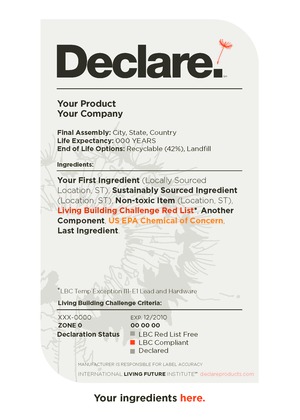
Thanks to a $3-million grant from Google Inc., the U.S. Green Building Council plans to build a body of scientific evidence around the content of green building products and materials. USGBC says the research will make it easier to have discussions with interested parties, including opponents of the expanded eco-friendly product credits in the proposed update of LEED—the USGBC's green building rating system.
The credits discourage the use of products with content deemed harmful to human health and the environment. The "credits [for ingredient transparency] have been causing lots of anxiety," says Scot Horst, Washington, D.C.-based USGBC senior vice president for LEED, which stands for Leadership in Energy and Environmental Design. Under the grant, "we will reach out to stakeholders and work with people we know we may not agree with," he adds.
The ingredient-disclosure topic is especially volatile among product and material suppliers. In July, based on concerns about LEED, the American Chemistry Council and other special-interest groups formed the American High-Performance Buildings Coalition. The group wants green building codes, standards, rating systems and credits developed in conformance with "full ANSI- or ISO-type consensus processes." It also wants performance-based, rather than point-based, LEED ratings (ENR 7/23 p. 8).
The coalition hopes USGBC will use the grant to enhance its credit development process to allow for "meaningful participation and input from materially interested stakeholders," says Richard Church, executive director of the Plastic Pipe and Fittings Association, a coalition member. "The coalition looks forward to any opportunity to work with USGBC on those enhancements," he says.
USGBC announced the two-year grant project at its Greenbuild International Conference and Expo, held on Nov. 14-16 in San Francisco. Grant funds will also support "outreach and dialogue" and the development of tools to help with product and materials selection.
LEED is based on a 100-point system of credits. The proposed material content transparency and optimization credits are part of LEED Version 4, which goes to ballot in June. USGBC says there are 50,000 LEED projects certified and registered for certification in 135 nations.
Also at Greenbuild, the Healthy Building Network launched the first public version of the Health Product Declaration, developed by the non-profit HBN and BuildingGreen. HPD Open Standard Version 1 is a format for reporting product content and associated health information, including hazards, for individual building products and materials. The form can be downloaded for free at hpdcollaborative.org.
The standard enables transparent disclosure and use of information regarding building product content and its associated health information by defining the critical information that is needed by building designers, specifiers, owners and users, says James Connelly, Living Building Challenge (LBC) coordinator for the International Living Future Institute, Seattle.
The Living Building Challenge is a sustainability standard compatible with LEED, but it's more demanding. LBC has its own product declaration form, based largely on HPD's pilot. But the LBC form, called Declare, goes further than HPD by asking for raw-material source location and final assembly location.


Post a comment to this article
Report Abusive Comment